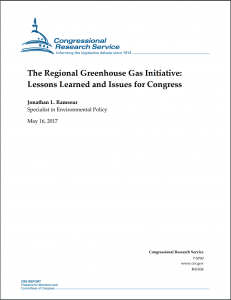Full Title: The Regional Greenhouse Gas Initiative: Lessons Learned and Issues for Congress
Author(s): Jonathan L. Ramseur
Publisher(s): Congressional Research Service
Publication Date: May 1, 2017
Full Text: Download Resource
Description (excerpt):
The Regional Greenhouse Gas Initiative (RGGI) was the nation’s first mandatory cap-and-trade program for greenhouse gas (GHG) emissions. RGGI involves nine states—Connecticut, Delaware, Maine, Maryland, Massachusetts, New Hampshire, New York, Rhode Island, and Vermont. The RGGI cap-and-trade system applies only to carbon dioxide (CO2) emissions from electric power plants with capacities to generate 25 megawatts or more—approximately 168 facilities. The RGGI emissions cap took effect January 1, 2009, based on an agreement signed by RGGI governors in 2005.
The results of the RGGI program may be instructive to policymakers. Several of RGGI’s design elements generated considerable interest during the development and debate of federal proposals to address GHG emissions. In particular, the program’s emissions cap has received particular attention. When the original cap took effect in 2009, it did not compel regulated entities to make internal emission reductions or purchase emission credits from other sources. Several factors led to this outcome: RGGI’s cap design, an economic downturn, and a substantial shift to less carbon intensive fuels. For instance, in 2005, RGGI states generated 33% of their electricity from coal and petroleum, sources of energy with relatively high carbon intensity. In 2016, these sources generated 7% of RGGI’s electricity.
To address the disparity between the cap and actual emissions, RGGI states agreed (in 2013) to reduce the existing cap (by 45%) so that the cap level would match actual emissions. The revised cap took effect in January 2014. RGGI’s revised cap may have vastly different effects than its predecessor. It is uncertain how this new development may impact electricity use and prices in the RGGI region and, in turn, the perception and support for the program.
Although actual emissions were ultimately well below the original emissions cap, the cap’s existence attached a price to the regulated entities’ CO2 emissions. Because the cap level was above actual emissions, the allowance price acted like an emissions fee or carbon tax. Although the cap likely had limited direct impact on the region’s power plant emissions, the revenues generated from the emission allowance sales likely had some impact on emission levels in the region.
Through 2016, RGGI states, as a group, have sold 91% of their emission allowances through quarterly auctions. The auction proceeds—over $2.7 billion to date—have provided a new source of revenue, which has been used to support various policy objectives. RGGI states (as a group) have distributed the vast majority of the emission allowance value to support energy efficiency, renewable energy, other climate-related efforts, or electricity consumer assistance. Several RGGI studies indicate that supporting energy efficiency provides multiple benefits: emission reduction, consumer savings via lower electricity bills, and job creation
